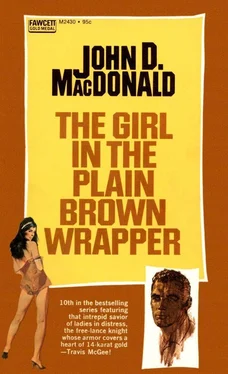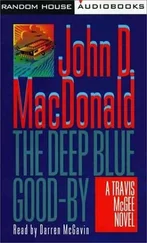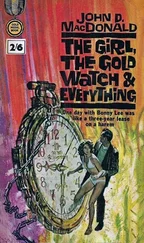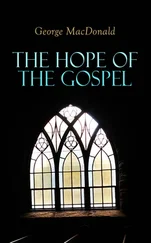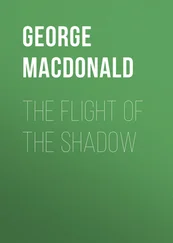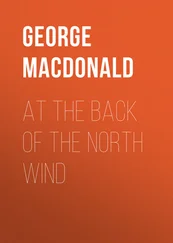John D. MacDonald
The Girl in the Plain Brown Wrapper
It is one of the sorry human habits to play the game of: What was I doing when it happened?
After I heard that Helena Pearson had died on Thursday, the third day of October, I had no trouble reconstructing the immediate past.
That Thursday had been the fourth and final day of a legitimate little job of marine salvage. Meyer made a lot of small jokes about Travis McGee, salvage expert, actually doing some straight-arrow salvage. He kept saying it almost made my cover story believable. But he did not say such things for any ears but mine own.
Actually it was not my ball game. Meyer gets himself involved in strange little projects. Somewhere, somehow he had gotten interested in the ideas of a refugee Cuban chemist named Joe Palacio. So he had talked a mutual friend of ours, Bobby Guthrie, a damned good man with pumps and pressures and hydraulics, into listening to Joe’s ideas and going to Joe’s rooming house in Miami where Joe had set up a miniaturized demonstration in an old bathtub he had scrounged somewhere.
When Bobby got high enough on the idea to quit his regular job, Meyer put in the money and they formed a little partnership and named it Floatation Associates.
Then Meyer, in one of his mother hen moods, sweet-talked me into donating my services, plus my houseboat, The Busted Flush , plus my swift little Muñequita boat to the first actual salvage operation. So I had to take the Flush down to a Miami yard where they winched aboard a big ugly diesel pump with special attachments rigged by Bobby Guthrie, some great lengths of what appeared to be reinforced fire hose, and several fifty-five-gallon drums of special gunk mixed up by Joe Palacio, plus scuba tanks, air compressor, tools, torches, and so on. Once I had topped off the water and fuel tanks and laid aboard the provisions and booze, the old Flush was as low in the water as I cared to see her. Even with all her beam, and that big old barge-type hull, she had to react to what Bobby estimated as seven thousand pounds of extra cargo. She seemed a little discouraged about it.
“If she founders,” Meyer said pleasantly, “we’ll see if we can raise her with Palacio’s magic gunk.”
So we took off down Biscayne Bay with the Muñequita in tow, heading for the lower Keys. We got an early start and kept waddling along, and by last light we were far enough down Big Spanish Channel to edge cautiously over into the shallows off Annette Key, in the lee of a southwest breeze, and drop a couple of hooks.
The immediate forecast was good, but there was an area of suspicion over near the Leeward Islands, and there was an official half month of the whirly-girl season left. Also the girls are known to come screaming up through hurricane alley after the season is over.
Later I learned that Helena Pearson had written the letter to me that same Saturday, September 28th, the day after she guessed she wasn’t going to make it, the letter the attorney mailed, still sealed, with his cover letter. And with the certified check.
That evening at anchor aboard The Busted Flush the three Floatation associates were edgy. For Meyer it was simple empathy. He knew the risks they were taking. Joe Palacio had a chance to make a new career in his adopted land. Bobby Guthrie had a wife and five kids to worry about. The three of them had periods of contagious enthusiasm, and then they would get the doubts and the glooms and the hollow laughter. If it worked on a very small scale in the scavenged bathtub, that didn’t mean it was going to work out in Hawk Channel, in the Straits of Florida, in seventy-five feet of ocean.
In the morning we went south down Big Spanish, past No Name Key, and under the fixed bridge between Bahia Honda Key and Spanish Harbor Key. Then the overladen Flush was out in the deeps, and we had a nine-mile run at about 220 degrees to lonely little Looe Key, across a slow heave of greasy swell. Soon I was able to pick up the red marker on Looe with the glasses. On the way, while on automatic pilot, I had figured out the quickest and best way to run if things blew up too suddenly. I would pour on all the coal and run just a shade east of magnetic north, perhaps 8 degrees, and if I could manage to make eight knots, I could tuck the Flush into Newfound Harbor Channel in maybe forty minutes, and find a protected pocket depending on the wind, maybe in Coupon Bight or close offshore by Little Torch Key.
Bobby Guthrie had the coordinates on the sunken pleasure boat. She lay a half mile southwest of Looe Key. She’d been down there for two months. She was the ’ Bama Gal , owned by a Tampa hotelman, about ninety thousand dollars’ worth of cabin cruiser, only six months old. Forty-six feet, fiberglass hull, twin diesels. The hotelman and his wife and another couple had been out fishing and the hotelman had keeled over with a heart attack while fighting a billfish. Nobody else aboard knew how to run the ship-to-shore radio. They barely knew how to run the boat. There was a tug with a tow of three barges about a half mile farther out, so they figured that the tug would have a radio they could use to call a Coast Guard helicopter and get the man to a hospital. The guest ran the boat over toward the tug and cut the engines and they all started waving their arms. Maybe they thought that tugs and barges have some kind of braking system. The tug captain tried evasive tactics, but mass and momentum were too much. The forward port corner of the lead barge put a big ugly hole in the cruiser, but the crew launched a skiff and got the people off in good order before she went down. By the time the Coast Guard arrived, the owner was as dead as the other fish they had caught, which had gone down with the cruiser.
The insurance company had paid off on the cruiser, and Meyer had gotten a release from them, so any recovery was going to be profit — if we could bring it up, tow it in, and find something worth money.
So on that Sunday I worked the Flush into the most protected water that Looe provides. It is shaped like a backward “J” that has fallen onto its back, and I put the hooks out in shoal water, as close as I could get without risking being hard aground at low tide. We took the Muñequita out and located the ’ Bama Gal after about forty minutes of skin diving and looking. We made a bright red buoy fast to her, and then I ran the Muñequita up-current, put the anchor down in about seventy feet, and let her come back to the buoy before snubbing her down, almost at the end of my four hundred feet of anchor line. Not enough scope to be sure of holding.
We had just the two sets of tanks aboard the Muñequita , so I went down with Joe Palacio to get a good look at what condition she was in. She lay on a little slope, bow higher than the stern, and she was on about a fifteen-degree list to port, making the hole in the starboard side, a little aft of amidships, easy to see. She was picking up new grass and weed and green slime, but it wasn’t too bad yet. We had expected to find her picked clean of everything the skin-diver kids could lift, but by some freak of chance they hadn’t found her. The big rods with their Finor reels were still in the rod holders. Binoculars, booze, cameras, tackle boxes, rifle, sunglasses — all the toys and gear and gadgets that people take to sea were either stowed or lay on the cockpit, cabin, or fly-bridge decking. While Joe busied himself with studying the hatches and the interior layout, and measuring interior spaces, I kept assembling bundles of goodies and, with a couple of pulls on the dangling line, sending them up into the sunlight.
When we went up, I found that all the stuff had looked better down in the depths, green and shadowy, than up on the deck of my runabout, all sodden, leaking, and corroded.
Читать дальше
